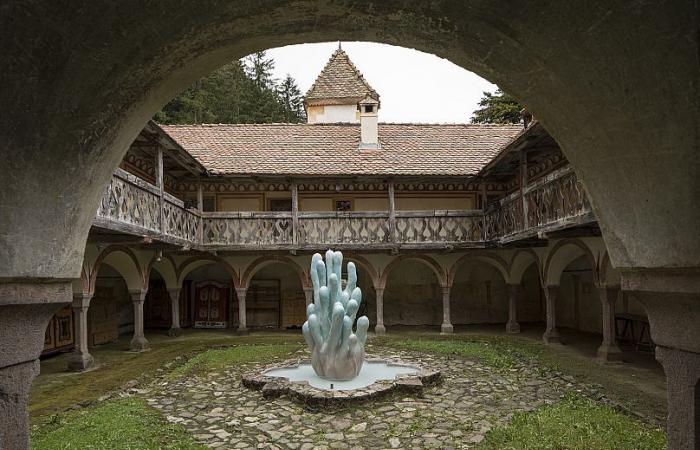From a horse-riding beetle to an underground forest, these works from the Gherdëina Biennale in Italy’s Tyrolean Alps are as intriguing as they are powerful.
Now in its ninth edition, the Gherdëina Biennale presents more than 30 artists and collectives – bringing new commissions, existing artworks and performances into dialogue with the spectacular UNESCO-protected Dolomites – as well as rich folklore and culture ladine who lives there.
Organized by Italian historian and art curator Lorenzo Giusti, with Marta Papini as deputy curator, the 2024 exhibition has the theme “The Parliament of Marmots”. This title borrows from a local Ladin myth about the Fanes – the legendary founding population of the Ladins, prosperous thanks to their alliance with the marmots with whom they shared the land.
Building on the cultural links between the region and the Mediterranean, participating artists – covering a wide range of disciplines – come from across Europe, North Africa and the Middle East. Drawing on the Ladin legend, they are interested in the land as a space for meeting history and nature, but also on which to write new stories.
Here are eight artists not to be missed:
Diana Policarpo – Fontaine d’Anguane (2024) and Fontaine d’Anguane, stream (COBRACORAL) (2024)
Perched on a picturesque hillside, the grand Castel Gardena is home to a number of Biennale artworks, including Diana Policarpo’s Anguane Fountain (2024), which sits in the courtyard of the historic castle.
Policarpo’s ethereal sculpture, springing from an ancient fountain, is inspired by the shape of a carnivorous sponge from the depths of the ocean and is the artist’s homage to the “anguanes”: female figures from Ladin mythology, traditionally associated with water and known as guardians of mountains, forests and waters.
Reinforcing the delicate intertwining of themes of feminism, folklore and interspecies relations, Policarpo’s sculpture is paired with an experimental and otherworldly sound composition that brings together human and non-human, verbal and non-verbal sounds.
Nadia Kaabi-Linke – Mushroom (2024)
“If you go out (into the forest), pay attention to the ground. You will see that the roots are really very thick, very visible,” explains Nadia Kaabi-Linke. Inspired by falling trees caused by summer storms, the Tunisian and Ukrainian artist of Berlin origin transformed a cellar in the center of Ortisei into an underground forest: the roots of the trees seem to grow from the ground and carve out a path through the concrete, the forest once again reclaiming an urban space.
“I wanted to create a work that brings friction between culture and nature. I wanted to see the roots growing into the structure of the building,” Kaabi-Linke muses, encouraging visitors to stay inside long enough for their eyes to adjust to the darkness. “It’s not bad, it’s not good, it just is,” Kaabi-Linke says of nature. “Our thing is just to be with her and find our way of being. What if we stopped, breathed and were like nature.
Julius von Bismarck – Beetle on a Horse (2024)
The Ladybug on a Horse by German artist Julius von Bismarck stands proudly in the center of Ortisei. Finding a monument to a hero on horseback is not unusual, but the hero in question here is quite different: a combination of a human and a bark beetle, a tiny creature that burrows into trees and chews their bark .
This forest pest has caused the disappearance of sections of forest in the Dolomites – visible on the hills surrounding the city – with climate change exacerbating the threat. Describing the beetle as a triumphant conqueror, von Bismarck asks: is nature the true scourge of the environment, or is it man? “He is an ambassador for animals or other (non-human) life that teaches us something,” says von Bismarck.
Atelier dell’Errore – Vela Alpina (2024) and Marmottoloide (2024)
In response to the theme “The Parliament of Marmots,” Atelier dell’Errore, a neurodivergent art collective based in Reggio Emilia, transformed the Biennale offices in Pontives with its depictions of what artistic director Luca Santiago Mora calls them “Marmottoloids” – futuristic creatures with a distinctive look. punk atmosphere, each with its own story.
Additionally, the group – whose only rule, as Mora explains, is that “no mistake can be erased during the artistic process” – presents its “Vela Alpina” (“Alpine Sailing”) on a lamppost in front of the Biennale Palace. Headquarter.
This piece, based on a material that transforms the thermal blankets used by migrants on the shores of the Mediterranean into an efficient sail, is both a nod to the sea that shaped the Dolomites 250 million years ago years and a reversal of the narrative: what was once lifesaving material, today it is a symbol of hope, progress and empowerment.
Nassim Azarzar – The Edge of the Forest (2024)
Having developed the visual language of this work during long-term research in Morocco, Nassim Azarar combines North African shapes and colors with the landscapes and folklore of the Dolomites to create a striking mural on the hotel’s facade historic Ladinia.
Born in France to Moroccan parents, Azarzar adorns the building with an abstract work reminiscent of a Moroccan mosaic – each painted section having its own story to tell, while combining to convey a deep connection between humans, nature and the universe at large.
Laurent Le Deunff – Snow Owl, Crocodile, Snail (2024)
When you walk through the door of the Gherdëina Biennale offices, an unexpected sight greets you: something between a fairytale forest and an animal cemetery. The Snow Owl, Crocodile, Snail by Laurent Le Deunff uses tree bark, moss, plants and saplings to create an enchanting secret garden in the building’s lobby, inhabited by dedicated tombstone-like monuments to a snowy owl, a crocodile and a snail. As Le Deunff explains, he made these effigies using the “rocaille” technique, in which concrete is carved to resemble wood – particularly relevant in a region like Val Gardena, known for its tradition of wood carving.
“This rock art… this kind of sculpture with a head on a pedestal, it’s generally for a human representation,” explains the artist. “It’s like a cemetery here… but the art is dedicated to non-human animals. » Full of surprise and more than a touch of humor, Le Deunff’s work recalls both the connections between human and non-human animals and the fact that things may not be quite as they seem. ‘they appear.
Ingela Ihrman – First Came the Ocean (2024)
On the top of the Juac plateau, Swedish artist Ingela Ihrman presents the only intervention of the Biennale in the countryside.
His installation “First Came the Ocean” sees trunks and branches of fallen trees, victims of recent storms and the bark beetle epidemic, forming the mammoth skeleton of a marine animal – a reflection on what the Alps, coral reefs and plateau meadows. were the seabed.
“I have made human skeletons: one in Sweden, one as part of the Eden Project a few years ago. It becomes very sad – almost like crying over a human body,” says Ihrman, contrasting this with the (rather more meditative and abstract) making of the skeleton of “an animal that doesn’t exist.”
Ruth Beraha – Il Cielo et Dei Violenti (2024)
What Ruth Beraha’s sound installation “Il Cielo è Dei Violenti” lacks in images here, it makes up for in impact. The artist’s immersive audio work – produced in consultation with a local ornithologist – takes over a disused theater hall.
Experienced in darkness, the installation begins with idyllic bird songs, followed by the cries of native and migratory birds and building into a frenzied, almost violent cacophony of bird calls and wing beats. .
Although the gentle song of the first bird also brings the soundscape to an end, the dystopian crescendo of the audio is an ungentle reminder of the power of nature.
The ninth edition of the Gherdëina Biennale: The Parliament of Marmots will take place until September 1, 2024 in the locations of Ortisei, Pontives and Selva Val Gardena.






